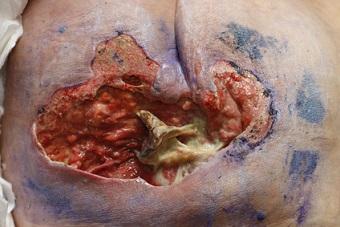Classification and Management of Fistulas
February 15, 2018
A fistula is an abnormal opening between two areas that typically shouldn't be connected, or with an epithelialized tract. An example is an opening from the bowel to the abdominal wall, termed enteroatmospheric or enterocutaneous (the terms are sometimes used interchangeably) because this fistula is exposed to the atmosphere, or is open from the abdomen to the skin, and typically needs to be pouched or some type of containment of the effluent.
Other types of fistulas can occur within the body itself such as between the bowel and bladder (enterovesical fistula), the bowel and vagina (rectovaginal or vesicovaginal fistula), and the trachea and esophagus (tracheoesophageal fistula, typically seen with esophageal atresia and cancers), as well as a spit fistula or esophagostomy (sometimes created on purpose and sometimes accidentally, typically seen with different types of head and neck cancer and/or to manage sections in patients who cannot swallow).
An arteriovenous fistula, which is typically created on purpose to provide patients who are undergoing hemodialysis with an access point without the infection risk of a permanent, invasive line, is a fistula type that is very different from the others. I'm always quick to clarify the difference between a fistula made on purpose and one that is not intended to happen with my students, new nurses, and peers... the terms can be confusing!
Clinical Goals for Fistula Management to Preserve Quality of Life
Not only can fistulas be confusing, but they are typically not fun, by causing significant impacts on quality of life for many people. My goal with fistula management is to provide the patient with the best quality of life possible given the circumstance. This typically means to contain the effluent, manage odor, protect perifistular skin, and consider lifestyle modifications that can help.
Fistula management really requires a multidisciplinary approach with involvement of the dietitian (nutrition is very important and can really influence the overall picture in so many ways), primary care provider (fluid and electrolyte balance and medication management are very important), and typically involvement of a colorectal surgeon, ear, nose, and throat surgeon, a urologic surgeon, gynecological surgeon, urogynecologist, or general surgeon based on the location of the fistula and the goals of care. This is especially important if surgical management of the fistula is indicated based on the patient's age, medical status, and overall prognosis. It is important to consider that some fistulas are best approached from a palliative standpoint with non-invasive and conservative management taking precedence.
Fistula Diagnosis and Management
Diagnosing a fistula usually involves a clinical exam along with some type of imaging or even a fistulogram, enema, or scope procedure. It is important to explain things to patients in terms they understand and to get a solid understanding of their personal goals of care.
For best management of the fistula, we need to look at the location and amount of drainage, along with odor (if there is any). Depending on the amount of drainage, some fistulas can be managed with a simple dry dressing a few times per day with a barrier cream to protect the perifistular skin. Other fistulas need to be pouched to manage drainage and odor. Fistulas that need to be pouched are typically enteroatmospheric fistulas on the abdomen (usually after abdominal surgery); spit fistulas can also be managed with a small pediatric pouch as needed. It is also important to consider whether a patient is receiving radiation therapy because many creams, gels, etc., are not safe to enter the field of radiation and can cause further skin irritation or radiation dermatitis.
Take away points for fistula management include the following:
- Take a multidisciplinary approach and involve key players—WOC specialist, physician, dietitian, surgery, specialty services.
- Ask about and understand the patient's goals for fistula management—curative versus palliative versus another approach.
- Manage odor and contain drainage while protecting perifistular skin.
- Continually involve patients in their care as much as possible.
- Look closely at diet, medications, and fluid or electrolyte imbalance.
Fistula management usually isn't easy, but it can be done with the right tools and approach. Different types of fistulas and the management strategies for each can be confusing, but remember to use your resources and take a multidisciplinary approach!
About the Author
Holly is a board certified gerontological nurse and advanced practice wound, ostomy, and continence nurse coordinator at The Department of Veterans Affairs Medical Center in Cleveland, Ohio. She has a passion for education, teaching, and our veterans. Holly has been practicing in WOC nursing for approximately six years. She has much experience with the long-term care population and chronic wounds as well as pressure injuries, diabetic ulcers, venous and arterial wounds, surgical wounds, radiation dermatitis, and wounds requiring advanced wound therapy for healing. Holly enjoys teaching new nurses about wound care and, most importantly, pressure injury prevention. She enjoys working with each patient to come up with an individualized plan of care based on their needs and overall medical situation. She values the importance of taking an interprofessional approach with wound care and prevention overall, and involves each member of the health care team as much as possible. She also values the significance of the support of leadership within her facility and the overall impact of great teamwork for positive outcomes.
The views and opinions expressed in this blog are solely those of the author, and do not represent the views of WoundSource, HMP Global, its affiliates, or subsidiary companies.












Follow WoundSource
Tweets by WoundSource